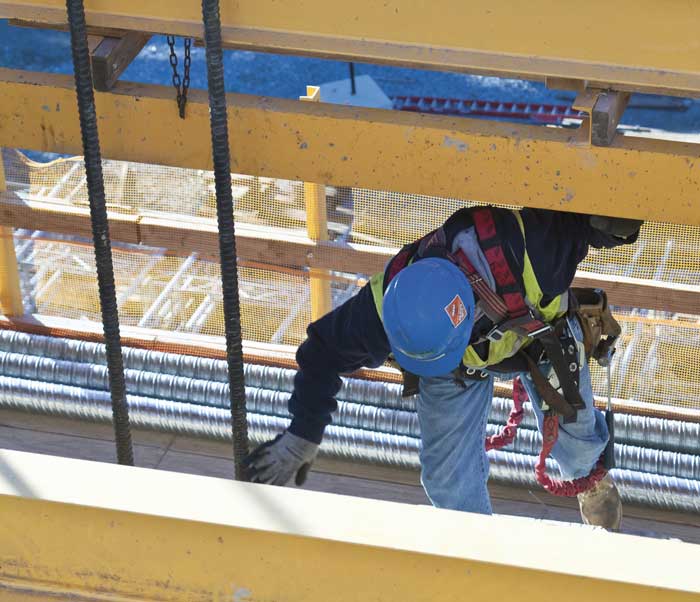The American National Standards Institute (ANSI) has served as coordinator of the voluntary standardization system for more than 90 years and provides an unbiased platform for the development of policies on standards issues. The institute serves as a regulator for standards development and conformity assessment programs and processes. ANSI does not actually develop standards. Instead, standards are developed by the Accredited Standards Committee, which functions under the procedures of ANSI with the American Society of Safety Engineers (ASSE) as secretariat.
Basic fall safety principles are covered under the Z359 Fall Protection Code to arm employers with the means to develop, implement and maintain fall protection programs. Recently updated, ANSI/ASSE Z359.14-2012 Self-Retracting Devices (SRDs) for Personal Fall Arrest and Rescue Systems, a standard encompassing the performance, design, qualification testing, markings, instructions, inspections, maintenance, storage and removal from service of SRDs, also includes standards for self-retracting lanyards (SRLs), as well as SRLs with integral rescue capability (SRL-R) or leading-edge capability (SRL-LE).
The Z359 standard establishes requirements for SRDs intended for use in personal fall arrest or rescue systems for authorized workers within the range of 130 to 310 pounds (59 to 141 kg) and applies to the manufacturers, distributors, purchasers and authorized individuals who use such equipment. This new standard addresses all types of SRDs, including the traditional-style SRL and SRLs with retrieval capability (commonly referred to as three-way SRL devices).
 General Requirements for Self-Retracting Devices
General Requirements for Self-Retracting Devices
The standard dictates that any integral rings intended to accept a snaphook or carabiner must be designed to minimize the likelihood of rollout of a corresponding snap hook or carabiner. The locking or fall-stopping function must be automatic, and you should not be able to override the self-locking feature. The visual load impact indicator will now be required with SRDs. This indicator should be visible to the user at full extension of the line prior to use. It’s important that consideration be given to size and location of the indicator. For example, if the indicator is on the housing and the unit is mounted overhead, the indicator should still be visible if activated. Retraction tension should be between 1.25 and 25 pounds at all points in the range of motion.
Integral Rescue Capability
Rescue planning is a crucial component in any fall protection program. As such, specifications and qualification testing for post-fall arrest testing of self-retracting lanyards with integral rescue capability are covered in the new standard and include function testing, static strength and dynamic performance testing.
The SRL-R should be engaged in its rescue mode of operation at any time, should not be able to inadvertently switch to or from rescue mode, should be capable of raising or lowering the load to affect the rescue and should automatically stop and hold the load if the rescuer relinquishes control.
The standard also covers the line constituent of SRDs. Synthetic rope and webbing must be made of pure or non-recycled synthetic materials with strength, aging, abrasion and heat-resistance characteristics equivalent or superior to polyamides. When statically tested, they must have a minimum breaking strength of 4,500 pounds. Wire rope must be manufactured from stainless steel or galvanized steel strand having a minimum breaking strength of 3,400 pounds and a minimum nominal diameter of 0.1875 inches.
Leading Edge
SRDs intended for use in leading-edge applications are now required to meet criteria that evaluate the performance of self-retracting devices with leading-edge capability. All SRL-LEs must include an integral energy absorber adjacent to the end of the line that connects to the body support. If the device housing is to be connected to the body support and can be used only in this manner, an energy absorber is not necessary.
Marking requirements for self-retracting lanyards with leading-edge capability are also specified and include minimum installation setback distance and clearance required when falling over the edge. Anchorage type and location, worker height, arrest distance and the clearance safety factor should be considered when determining fall clearance.

User Inspection, Maintenance and Storage
Most importantly for contractors, the new standard includes the requirements for more frequent and formal inspections by users, manufacturer-authorized distributors, repair centers and others. Detailed SRD inspection requirements will be identified in the user instruction manuals provided with each product. At a minimum, this equipment must comply with the manufacturer’s instructions regarding the inspection, maintenance, storage and removal from service.
On the jobsite, equipment must be inspected by authorized personnel other than the user before each use. Additionally, equipment should undergo periodic factory-authorized inspections. Inspection criteria should be kept current in relation to changing patterns or conditions of use.
Documentation of equipment inspections must be maintained by the program administrator. This documentation should include, at a minimum, the identity of the equipment, inspection date, name of the person conducting the inspection and the results of the inspection. When an inspection reveals defects, damage, inadequate maintenance, activated stress indicators or activated warning devices, the equipment must be permanently removed from service or undergo corrective maintenance in accordance with the manufacturer’s recommendations. Finally, if the equipment has arrested a fall, it must be removed from service, tagged as “UNUSABLE” and either disposed of or serviced in accordance with the manufacturer’s recommendation.
Aside from equipment that has arrested a fall, any equipment that requires repairs must also be tagged as “UNUSABLE” and removed from storage until maintenance is completed in accordance with the manufacturer’s instructions.
Proper storage of equipment includes ensuring protection from damage due to environmental factors such as heat, light, excessive moisture, oil, chemicals, vapors or any other harmful component.
While these are the main requirements to be aware of when using fall arrest systems, the points here are not comprehensive. The full copy of the ANSI/ASSE Z359.14-2012 standard can be purchased from the ANSI standards store at www.webstore.ansi.org.
